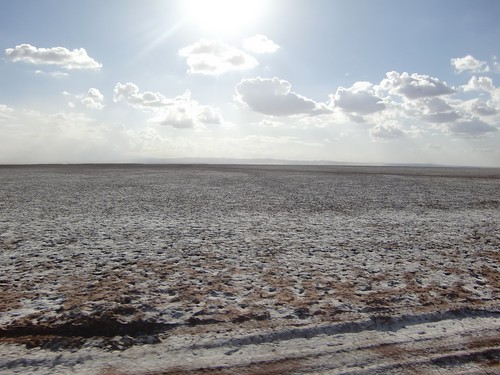 While livestock production levels in developed countries are holding steady, livestock production systems in developing countries, particularly in the emerging economies, are rapidly changing to meet a rapidly growing demand for livestock foods due to those countries’ growing populations, cities and incomes. Some of these fast-evolving livestock production systems are using ever-larger quantities of water and other natural resources and emitting ever-larger amounts of greenhouse gases, which are causing global warming. Many people are questioning whether the increasing demand for meat and milk in developing countries can be met within equitably negotiated and sustainable greenhouse gas emission targets.
While livestock production levels in developed countries are holding steady, livestock production systems in developing countries, particularly in the emerging economies, are rapidly changing to meet a rapidly growing demand for livestock foods due to those countries’ growing populations, cities and incomes. Some of these fast-evolving livestock production systems are using ever-larger quantities of water and other natural resources and emitting ever-larger amounts of greenhouse gases, which are causing global warming. Many people are questioning whether the increasing demand for meat and milk in developing countries can be met within equitably negotiated and sustainable greenhouse gas emission targets.
The (surprising) answer is ‘yes’. Research tells us that emissions from livestock systems can be reduced significantly through technologies and policies, along with incentives for their implementation.
Livestock and greenhouse gas emissions
Livestock contribute up to 18% of the global greenhouse gas emissions that are ‘anthropogenic’, or generated by human activity. The main greenhouse gases from livestock systems include methane produced by the belching of animals (25 per cent), carbon dioxide (CO2) produced by uses of land that encourage the decomposition of organic substances (32 per cent), and nitrous oxide (N2O), commonly known as ‘laughing gas’, produced by spreading manure and slurry over lands (31 per cent).
As one would expect with such great differences in livestock production systems in different regions of the world, different systems in different regions emit very different amounts and types of greenhouse gases. Overall, most emissions to date have come from industrialized countries practicing factory farming, the least from developing-country family farms. Moreover, two of the most significant contributors to the greenhouse gases produced by livestock systems in the developing world are the rapidly expanding industrial livestock operations in Asia and deforestation in Latin America to make room for livestock grazing and feed crop production.
That said, however, it is also true that the emissions per animal in poor countries tend to be much higher than those per animal in rich countries, for the reason that most livestock in poor countries are maintained on poor diets that reduce the efficiency by which the animals convert their feed to milk and meat. And the increasing human populations, urbanization and demand for livestock foods in developing countries means that future increases in livestock greenhouse gases will come from the South. Livestock researchers at ILRI and elsewhere are helping people to manage trade offs among natural resource use, livestock emissions and livestock productivity. Seven ways to reduce greenhouse gases emitted by livestock Here are seven practical ideas for reducing the greenhouse gases emitted by livestock.
1 Reduce consumption of, and demand for, livestock foods in developed countries
Whereas under-consumption of livestock foods is a main problem in developing countries, over-consumption of livestock foods—including fatty red meat, eggs and full-fat milk and dairy products—damages the health of many people living in affluent societies. The demand for cheap livestock foods in rich countries in many cases is met by imports of livestock products or feed grains from the developing world, the transport and supplies of both of which can lead to environmentally damaging land-use practices and over-use of water and other natural resources, which in turn increase the levels of greenhouse gas emissions in those developing countries. Reducing the relatively high levels of consumption of livestock foods in the developed world would thus not only help improve the health of many people in rich countries but also reduce environmentally damaging livestock production practices in both rich and poor countries, leading to significant reductions in the emissions of carbon dioxide and methane gases.
This point raises another: to ensure that any negotiated emissions targets that may be established are equitable as well as feasible and useful, we shall also have to institute programs to track and account for the greenhouse gases ‘embedded’ in the many livestock and feed products traded worldwide. Such a system would give buyers of livestock products some understanding of the ‘greenness’ of the products they are buying. Common sense can no longer be our guide. Such are the complexities of modern food chains that beef raised on the pampas of Argentina and shipped to the North American Midwest might, for example, have generated lower levels of greenhouse gases than corn-fed beef raised, slaughtered and packaged right there in the Midwest.
2 Improve the diets of ruminants in developing countries
Providing cattle, water buffaloes, sheep, goats and other ruminant animals in developing countries with better quality diets increases their feed-conversion efficiencies and thus reduces the amount of methane generated in the production of a unit of meat or milk. Many small-scale farmers can, for example, improve the diets of their ruminant animals by better managing their grazing lands: they can rotate the pastures they use, plant improved species of pasture grasses, make strategic applications of animal manure, and develop ‘fodder banks’ of planted legumes and other forages. They can make use of more strategic combinations of available feed resources. Many crop-livestock farmers can supplement the poor grass diets of their animals with the residues of their grain crops after harvesting. (Although many cereal residues are of relatively poor nutritional quality, research by ILRI and the International Crops Research Institute for the Semi-Arid Tropics shows there is considerable potential for improving the nutritional quality of stover.) And some can give their ruminants feed additives that manipulate the microorganisms living in the rumen to quicken microbial fermentation. What’s needed are practical methods to monitor the effectiveness of mitigating greenhouse gases using these practices as well as policy environments to make implementing them cost-effective.
3 Help farmers in developing countries obtain and maintain higher-yielding breeds
Where resources allow and breeding services exist, replacing low-producing local animals of the developing world with fewer and better fed animals of higher yielding breeds would reduce total emissions while maintaining or increasing livestock yields. Such shifts include keeping more productive types of a given breed, such as by crossing local cows with genetically improved dairy cow breeds to produce cross-bred cows that possess traits both for both hardiness and higher milk yields.
4 Better match livestock species to environments in all countries
Switching species to find those better suited to particular environments and resources could raise animal productivity levels. In some circumstances, exchanging ruminant animals for pigs, chickens and other monogastrics (which possess single- rather than four-chambered stomachs) could reduce total methane emissions, although high amounts of grain used to feed the monogastrics can offset the methane saved. For this reason, alternative feeds and feeding practices for monogastrics urgently need the attention of the research and development communities.
5 Impose regulatory frameworks for managing manure in all countries
Regulatory frameworks could reduce nitrous oxide emissions from manures, particularly by enforcing better management of excreta in the larger livestock operations in developing countries and applications of slurry and manure in the developed countries. Furthermore, developing ways to monitor and verify reductions would open the door to mitigation payment schemes.
6 Apply land-use policies that forestall cultivation of new lands
Some carbon lost from agricultural ecosystems in the past can be recovered. Any management practice that increases the photosynthetic input of carbon and/or slows the return of stored carbon to carbon dioxide via respiration, fire or erosion will increase carbon reserves, thereby sequestering carbon. We can thus reduce carbon dioxide emissions by applying land-use policies that forestall the cultivation of new lands now under forest, grassland or non-agricultural vegetation.
And rangeland and silvo-pastoral livestock systems would store much greater amounts of soil carbon than they do now if we put in place land use and livestock policies and practices suited to local conditions. Such interventions could serve not only to sequester more carbon but also to provide smallholders farmers and herders with payments for the services their local ecosystems provide the wider community.
7 Provide incentives to adopt mitigation strategies, particularly for poor communities
Finally, successful implementation of livestock mitigation strategies, particularly in poor countries with scarce resources, inadequate rural and peri-urban infrastructure, and inappropriate agricultural policies, will demand a series of smart and equitable incentive systems that encourage people to adopt mitigation strategies and practices. Success in these countries will also depend on developing new kinds of links among institutions that have not formerly worked together, on reforming livestock and agricultural policies, on inventing techniques for monitoring carbon stocks, and on developing appropriate and easy-to-use protocols for verifying greenhouse gas emissions. But the lesson ILRI researchers have learned from their pastoral research may prove to be most relevant here: mitigation activities have the greatest chance of success in poor and hungry communities when they build on traditional institutions and knowledge while building up food security.
This is Chapter three of the ILRI Corporate report 2008–09: Download the full report
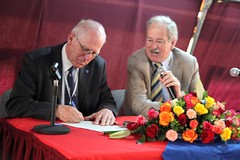 Knut Hove, chair of the board of trustees of the Africa-based International Livestock Research Institute (ILRI), yesterday, 14 April 2010, signed an agreement on behalf of ILRI to join a new Consortium of International Agricultural Research Centres.
Knut Hove, chair of the board of trustees of the Africa-based International Livestock Research Institute (ILRI), yesterday, 14 April 2010, signed an agreement on behalf of ILRI to join a new Consortium of International Agricultural Research Centres.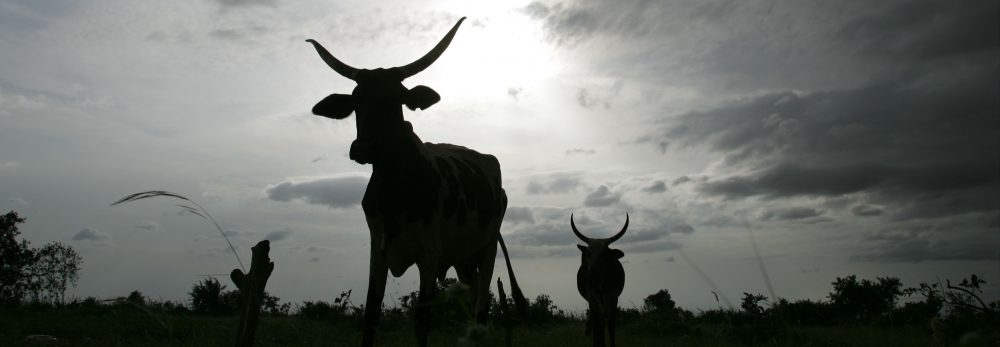


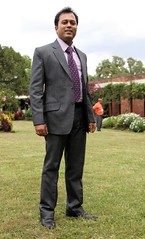
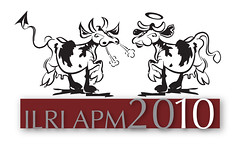 Later this month, many staff, partners and members of the board of trustees of the International Livestock Research Institute (ILRI) will gather in Addis Ababa, Ethiopia, for the institute’s annual program meeting. Alan Duncan, chair of the organizing committee, introduces below the theme for this meeting. ‘Livestock: the good, the bad and the ugly’.
Later this month, many staff, partners and members of the board of trustees of the International Livestock Research Institute (ILRI) will gather in Addis Ababa, Ethiopia, for the institute’s annual program meeting. Alan Duncan, chair of the organizing committee, introduces below the theme for this meeting. ‘Livestock: the good, the bad and the ugly’.